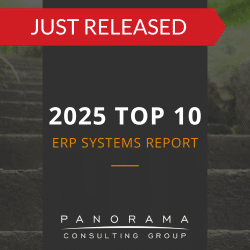When evaluating enterprise software, such as CRM systems or manufacturing ERP systems, you need to consider your overall IT infrastructure – current and future state. Will you stay on premise? Will you move to the cloud? Will you change the type of cloud environment you use?
If you’re considering cloud computing, there is certain terminology you must know. Today, we’re exploring the difference between hybrid cloud and multi-cloud, so you can determine which (if either) would benefit your organization.
What is Multi-Cloud?
A multi-cloud solution makes use of two or more cloud platforms/vendors. For example, a business might want to run its supply chain management system on Amazon Web services while using Microsoft Azure for demand forecasting.
This approach can be complex depending on how many cloud servers a business uses and how it leverages the resources of each.
Benefits of a Multi-Cloud Approach
1. Minimizes On-Site Infrastructure
On-site infrastructure can be difficult to manage, especially as a business is growing. With multi-cloud systems, companies can rely on an external provider for the majority of their business infrastructure.
This means they’re not as burdened by hardware, software, maintenance, and support.
Local infrastructure is also expensive to establish and run. Cloud storage and systems eliminate this expense and typically offer a pay-as-you-go model. The costs depend on the resources used.
Software Selection & Process Improvement Case Study
In helping the client get its project back on track, one of our primary focus areas was decreasing their customization needs by improving their processes to align with the system's best practices.
2. Allows You to Leverage Best-in-Class Features Across Providers
A multi-cloud strategy allows you to use different cloud environments in the ways they’re best suited. For example, you may want to host a test and a development workload on one cloud service and use AI or machine learning services from another.
What is Hybrid Cloud?
A hybrid cloud setup combines a private cloud and/or on-site infrastructure with a public cloud environment. This results in a single cloud computing environment that can leverage the benefits of both local and cloud computing.
A business might prefer this setup if it wants to use a public cloud environment while still maintaining a private cloud.
AWS is an example of one of the largest hybrid cloud service providers. They can provide their services to your on-site infrastructure or within their managed cloud environment.
Note: It’s important to consider the complexity of managing multiple environments, especially the data integration and security challenges. Our software failure experts have seen more than their fair share of data disasters.
Types of Hybrid Cloud Environments
Consistency is key in hybrid cloud environments. The provider needs to supply resources and services that work well with private clouds.
There are two common approaches to this.
The first is to create a private cloud stack that can integrate with a public cloud. This makes use of platforms and technologies from multiple providers.
The second approach has the software stack and services contained within specialized applications that integrate with a specific public cloud. This setup uses a single public cloud provider.
Benefits of Hybrid Cloud
1. Reduces Costs
Like a multi-cloud system, a hybrid cloud system reduces the need for on-site infrastructure. While it does make use of a private cloud setup, the hardware and software requirements are much lower and easier to work with.
2. Provides Flexibility
You can maintain your private cloud while making use of the benefits of the public cloud. This gives you a lot of control without being limited on resources.
3. Ensures Security and Compliance
You can keep your private infrastructure secure and use it for your most sensitive operations. Your public cloud provider will help you maintain compliance.
4. Increases Scalability
Hybrid cloud solutions can make scalability much easier. You can increase your usage to meet your needs without having to alter your on-site infrastructure.
The Key Difference Between Hybrid Cloud and Multi-Cloud
There are certain characteristics that hybrid cloud and multi-cloud solutions share. They both provide flexibility, redundancy, and highly tailored infrastructures. They also both convert upfront infrastructure costs into predictable, ongoing expenses.
It’s perhaps more important to note the differences.
The first of these is that multi-cloud systems only make use of public clouds. Hybrid cloud systems, on the other hand, can make use of both public and private clouds. This means hybrid clouds must be interoperable – able to connect public and private clouds to establish a single environment.
Selecting the Best Solution for Your Business
Even knowing the difference between hybrid cloud and multi-cloud, you might not be confident in making a decision at this point.
To find the best solution, you should speak to a cloud computing professional at Panorama Consulting. Our professionals not only have a technical background, but they are operational experts who can assess your business needs and align your technology decisions with your long-term goals.
Contact our ERP implementation consultants below for a free consultation.













